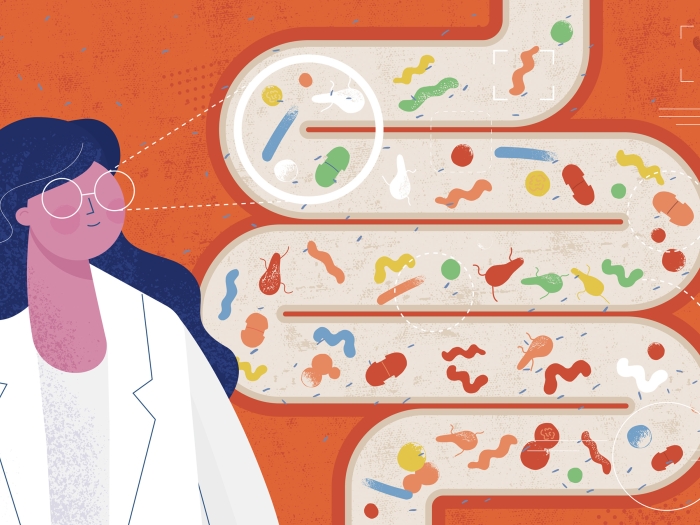The skin condition that gets little attention from the scientific community continues to be a focus for a Michigan Medicine researcher and dermatologist.
7:00 AM
Author |

Stretch marks are a vestige of pregnancy, weight gain, growth spurts and steroid use.
Considered more of a cosmetic issue and not medically dangerous, the condition hasn't received much scientific attention.
MORE FROM THE LAB: Sign up for our weekly newsletter
But one Michigan Medicine researcher is working to solve the stretch mark dilemma: What's happening below the surface of the skin?
"We're trying to find what causes stretch marks so that we can effectively treat them," says Frank Wang, M.D., associate professor of dermatology at Michigan Medicine.
With the occurrence of stretch marks, the skin's normally tight and densely packed collagen bundles separate. The collagen bundles become disorganized and then fail to re-bundle, resulting in the visible grooves that patients often want to eradicate.
Going skin deep
To learn more, Wang's team studied the formation of early stage stretch marks in pregnant women, called striae gravidarum, by using advanced, three-dimensional microscopic imaging to look at the organization of collagen — the protein that helps give skin its strength and support.
SEE ALSO: Largest Psoriasis Meta-Analysis to Date Yields New Genetic Clues
Conventional techniques of staining skin samples and examining gene expression also were used.
The study, published in the British Journal of Dermatology, included 28 participants, predominately Caucasian, who had recently developed reddish abdominal stretch marks during pregnancy.
Skin samples were taken of the stretch mark area and, for comparison, a normal region on the abdomen and the thigh. Each sample was 4 millimeters in diameter, about the size of a pencil eraser. For further comparison, some participants also had samples taken of stretch marks after delivery of their babies.
The research showed that collagen bundles within the stretch marks appeared more spaced out or separated than collagen bundles from skin on other parts of the body. In between the spaces separating the bundles were disorganized, thin collagen strands, or "fibrils," that were unable to bundle together.
"There's nothing else quite like it," says Wang. "We believe that it's the intense stretch during pregnancy that causes the separation and disruption of the collagen bundles."
"It seems to be that some patients' skin doesn't accommodate well to stretching, and the skin in those patients may be more prone to damage and disorganization of collagen," says Wang. "That's our best guess at the time."
Wang says mild forms of exercise don't seem to worsen stretch marks.
"In fact, mild stretching exercises and aerobics might help prevent stretch marks during pregnancy," Wang says, "so it appears to be stretching from within the abdomen that's more problematic."
If we can better understand how collagen bundles are assembled, we can apply that knowledge to many different conditions, including stretch marks and aged skin.Frank Wang, M.D.
Questions remain
Of the early stage stretch marks that were studied, another finding involved fibroblasts, the cells that make collagen. Fibroblasts were positioned very close or next to the disorganized collagen fibrils.
"This suggests that the disorganized fibrils were being newly made by the fibroblasts," says Wang.
Still, there is uncertainty about what happens next. After the fibroblasts make collagen, it's unclear why that collagen doesn't become a normal bundle, he says.
SEE ALSO: The Healing Function of Sweat Glands Declines with Age
But it does imply that the skin is attempting to repair collagen bundles damaged by skin stretching and is unsuccessful. Instead of reproducing normal bundles, the repair response leads to the looser, disorganized fibrils.
"At a more fundamental level, no one understands how collagen bundle formation happens precisely, even in normal skin," says Wang. "We don't know what may or may not help that bundling process or how that process occurs in the first place.
"If we can better understand how collagen bundles are assembled, we can apply that knowledge to many different conditions, including stretch marks and aged skin," says Wang, who notes that far more dermatology research focuses on normal and sun-based aging than stretch marks.
In those cases, "there's some fragmenting and spreading apart of collagen bundles, so there are similarities to the process occurring in stretch marks."
And there's no easy fix: Wang says most of the products marketed for preventing or improving the appearance of stretch marks aren't based on research or don't have a proven track record.
"Our view is that these products aren't based on science; many may act as moisturizers but don't seem to counteract stretch-related damage to collagen or its bundling," he says. "As a result, we hope to shed some light on strategies for improving stretch marks."
Further research will involve stretch marks at an even earlier stage.

Explore a variety of healthcare news & stories by visiting the Health Lab home page for more articles.

Department of Communication at Michigan Medicine
Want top health & research news weekly? Sign up for Health Lab’s newsletters today!





